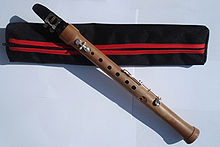- Chalumeau
-
This article is about the historical musical instrument. For the register on the clarinet that is named for this instrument, see Clarinet#Range.
The chalumeau (French: [ʃa.ly.mo], English /ˈʃæləmoʊ/; plural chalumeaux; from Greek: κάλαμος, kalamos, meaning "reed") is a woodwind instrument of the late baroque and early classical era, in appearance rather like a recorder, but with a mouthpiece like a clarinet's.
Contents
History
The word "chalumeau" was in use in French from the twelfth century to refer to various sorts of pipes, some of which were made of cane and featured a single "reed" cut into the side of the cane itself. (See Similar instruments, below. The etymology is discussed in detail at Shawm#Etymology.)
In the late seventeenth century an improved form of the chalumeau was developed. This baroque chalumeau represents the link between the recorder and the clarinet, and is essentially a cylindrical bore recorder with a mouthpiece like that of a clarinet and two additional "throat" keys controlling notes at the top of the fundamental register. The chalumeau continued to develop for several decades alongside the clarinet, and it has a large repertoire in 18th century orchestral and chamber music.[1]
The clarinet was developed from the chalumeau primarily by displacing the B♭ key up towards the mouthpiece, reducing the size of the hole and inserting a register tube; here it still produces B♭, but functions in addition as a register key, allowing the upper range to be easily sounded.[1] In addition the clarinet's mouthpiece was modified to improve performance in the upper register, and the chalumeau's straight foot joint was replaced by a flared bell. Early clarinets could be constructed with either the upper or the lower range well tuned, but not both. The baroque clarinet therefore was primarily used in its upper range, which had a bright sound and better projection than the mellow sounding chalumeau, aided also by the enlargement of the bell for resonance. Later developments in the keywork allowed better intonation throughout the range of the clarinet, contributing to its increased popularity throughout Europe, and to the demise of the chalumeau by about the mid 1780s.
Both the improvement of the chalumeau and the invention of the clarinet have been attributed to Johann Christoph Denner of Nuremberg, although his contributions are uncertain and in particular the clarinet may have been an invention of his son Jacob Denner.
Modern chalumeau
Although only about eight examples of original chalumeau are known to have survived, modern craftsmen are now producing replicas based on these instruments. Present day makers of replica chalumeau include Peter van der Poel, Andreas Schöni, R. Tutz, and Guntram Wolf. Other makers, including Hahl and Kunath, produce modern adaptations of the chalumeau. Today, the band In Extremo has three chalumeau players: Marco Ernst-Felix Zorzytzky, Andre Strugalla, Boris Pfeiffer.
Similar instruments
Single-tube, cylindrical, single reed folk instruments are found in many Arabic and European cultures; see Albogue, Alboka, Diplica, Hornpipe, pibgorn, and Sipsi. In the 1970s, a similar instrument called the xaphoon (also called "Maui bamboo sax" or "pocket sax") was developed by Hawaiian craftsman Brian Wittman.
Notes
The name Chalumeau is used by French organbuilders to denote a short-resonator organ stop used for color effects. It has a number of different pipe forms and possible voices, most of which are described as "Reedy, Buzzing, Clarinet-like, Caney, or soft but bright." The organ stop of this name is not intended to be orchestrally imitative of the clarinette.
- ^ a b Rice, Albert R. (1992). The Baroque Clarinet. Oxford: Clarendon Press. pp. 15–38. ISBN 0198161883.
External links
- Delicacy, sentimentality and intimacy: the chalumeau as 'signifier' - Ingrid Elizabeth Pearson
- Photo of an 18th-century chalumeau
Reproduction and modern chalumeau makers:
- Hanson Clarinets
- Hanson Music
- Hahl Blockflöten
- Jo Kunath
- Guntram Wolf
- Andreas Schöni (Historische Holzblasinstrumente)
- R. Tutz
- Peter van der Poel
Clarinet Clarinet family Systems of Fingering Clarinetists Heinrich Baermann · Acker Bilk · Walter Boeykens · Jack Brymer · James Campbell · Eddie Daniels · Buddy DeFranco · Eric Dolphy · Stanley Drucker · Pete Fountain · Martin Fröst · Benny Goodman · Woody Herman · Thea King · Henry Lazarus · Karl Leister · Sabine Meyer · Pee Wee Russell · Artie Shaw · David Shifrin · Anton Stadler · Milenko Stefanović · Richard StoltzmanClarinet makers Category:Clarinet makers · Category:Clarinet manufacturing companies · List of clarinet makers · Amati-Denak · E. K. Blessing · Buffet Crampon · Johann Christoph Denner · Benedikt Eppelsheim · Stephen Fox · Heinrich Grenser · Howarth of London · Jupiter Band Instruments · Leblanc · Iwan Müller · Adolphe Sax · Selmer · Yamaha CorporationOther Category:Clarinets · Category:Compositions for clarinet · Clarinet choir · Clarinet concerto · Clarinet sonata · Clarinet-violin-piano trioSingle reed instruments Modern Aulochrome • Clarinet • Bass clarinet • E-flat Clarinet • Heckel-clarina • Heckelphone-clarinet • Octavin • Saxophone • Tárogató (modern) • XaphoonEuropean historical ChalumeauEuropean traditional Middle Eastern traditional Central Asian traditional South Asian traditional Categories:- Woodwind instruments
- Early musical instruments
Wikimedia Foundation. 2010.

